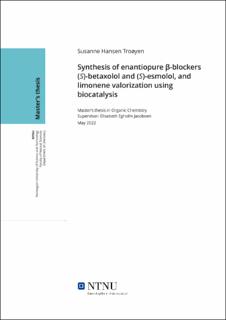| dc.contributor.advisor | Jacobsen, Elisabeth Egholm. | |
| dc.contributor.author | Troøyen, Susanne. | |
| dc.date.accessioned | 2022-06-25T17:20:23Z | |
| dc.date.available | 2022-06-25T17:20:23Z | |
| dc.date.issued | 2022 | |
| dc.identifier | no.ntnu:inspera:109833266:13559470 | |
| dc.identifier.uri | https://hdl.handle.net/11250/3000898 | |
| dc.description.abstract | Hovedmålet i denne masteroppgaven var å syntetisere (S)-betaxolol ((S)-10) og (S)-esmolol ((S)-15) ved å bruke Candida antarctica lipase B (CALB) som en enantioselektiv biokatalysator. Et annet mål i oppgaven var å teste ut biokatalytisk oksidasjon av limonen (16) for bærekraftig produksjon av mer verdifulle stoffer.
Flere synteseveier til (S)-betaxolol ((S)-10) fra utgangstoffet 4-(2-hydroksyetyl)fenol (1) ble prøvd ut, som vist i Skjema 0.4. 1-Klor-3-(4-(2-(syklopropylmetoksy)etyl)fenoksy)propan-2-ol (8a) og 1-brom-3-(4-(2 (syklopropylmetoksy)etyl)fenoksy)propan-2-ol (8b) ble syntetisert i hhv. 26% og 25% utbytte via to forskjellige ruter. Det ble også forsøkt å beskytte fenolen 1 med en tetrafluoropyridylgruppe (TFP), men alkyleringen som fulgte var ikke vellykket. CALB ble brukt til kinetisk oppløsning av 8a og 8b. Dette ga (R)-8a i 38% utbytte og 99% enantiomert overskudd (ee), og (R)-8b i 27% utbytte og 58% ee. Dermed ble det bestemt at klorhydrinen 8a var det beste substratet for CALB. (R)-8a ble omdannet til (S)-betaxolol ((S)-10) i 95% utbytte og 99% ee. Totalt utbytte for (S)-10 var 9%.
(S)-Esmolol ((S)-15) ble syntetisert gjennom fire steg, som vist i Skjema 0.5. Utgangstoffet metyl-3-(4-hydroksyfenyl)propanoat (11) ble omdannet til metyl-3-(4-(oksiran-2-ylmetoksy)fenyl)propanoat (12) i 68% utbytte. Epoksid 12 ble omdannet til metyl-3-(4-(3-klor-2-hydroksypropoksy)fenyl)propanoat (13) i 96% utbytte. CALB ble brukt til kinetisk oppløsning av 13. Dette ga (R)-13 i 43% utbytte og 97% ee. (R)-13 ble omdannet til (S)-esmolol ((S)-15) i 92% utbytte of 97% ee. Totalt utbytte for ((S)-15) var 26%.
Perillylacetat (18) ble syntetisert i 62% utbytte fra perillylalkohol (17). Det ble utviklet
en metode for GC-analyse av limonen oksidasjonsprodukter. Limonen (16) ble oksidert ved hjelp av selendioksid, som ga 1-metyl-4-(prop-1-en-2-yl)bensen (16b) som hovedprodukt. Det ble forsøkt å oksidere (R)- og (S)-limonen (16) ved hjelp av cytokrom P450, av typen CypExpress(TM) 2C19, 2C9 and 2D6. Disse oksidasjonene var ikke velykkede, og ingen oksidasjonsprodukter ble observert. Det ble observert at enzymet denaturerte ved høye enzymkonsentrasjoner eller ved reaksjonstider på 2 uker. (S)-perillylalkohol ((S)-17) ble syntetisert i 37% utbytte etter KRED 228-katalysert reduksjon av (S)-perillaldehyd ((S)-20). Disse reaksjonene er vist i Skjema 0.6. | |
| dc.description.abstract | The main objective in this thesis was to synthesize the two β-blockers (S)-betaxolol ((S)-10) and (S)-esmolol ((S)-15) using Candida antarctica lipase B (CALB) as an enantioselective biocatalyst. As a secondary goal, biocatalytic oxidation of limonene (16) was investigated in an attempt to produce more valuable compounds in a sustainable way. Several routes to (S)-betaxolol ((S)-10) from the commercially available precursor 4-(2-
hydroxyethyl)phenol (1) were tested, as shown in Scheme 0.1. Two successful routes (a
and b) to the halohydrins 1-chloro-3-(4-(2-(cyclopropylmethoxy)ethyl)phenoxy)propan-2-ol (8a) and 1-bromo-3-(4-(2-(cyclopropylmethoxy)ethyl)phenoxy)propan-2-ol (8b) were performed, giving 8a in a total yield of 26% and 8b in a total yield of 25%. A route to the intermediate 4-(2-(cyclopropylmethoxy)ethyl)phenol (2) through protection of 1 with a tetrafluoropyridyl (TFP) group was also attempted, but it was not successful. Kinetic resolutions of 8a and 8b using CALB were performed to afford (R)-8a in 38% yield and 99% ee, and (R)-8b in 27% yield and 58% ee. The chlorohydrin (8a) was determined to be the best substrate for CALB. (R)-8a was converted to (S)-betaxolol ((S)-10) in 95% yield and 99% ee. The total yield of (S)-10 was 9%.
A four-step synthesis to (S)-esmolol ((S)-15) was performed, as shown in Scheme 0.2. The commercially available precursor methyl 3-(4-hydroxyphenyl)propanoate (11) was converted to methyl 3-(4-(oxiran-2 ylmethoxy)phenyl)propanoate (12) in 68% yield. Epoxide 12 was converted to methyl 3-(4-(3-chloro-2-hydroxypropoxy)phenyl)propanoate (13) in 96% yield. Kinetic resolution of 13 using CALB was carried out to give (R)-13 in 43% yield and 97% ee. (R)-13 was converted to (S)-esmolol ((S)-15) in 92% yield and 97% ee. The overall yield of (S)-15 was 26%.
Perillyl acetate (18) was synthesized in 62% yield from perillyl alcohol (17). A GC method for analysis of 18 and several standard limonene oxidation products was developed. Limonene (16) was oxidized using selenium dioxide, which produced 1-methyl-4-(prop-1-en-2-yl)benzene (16b) as the main product. Cytochrome P450-catalyzed oxidation of (R)- and (S)-limonene ((R)/(S)-16) was attempted using CypExpress(TM) 2C19, 2C9 and 2D6. The oxidations were not successful, as no oxidation products could be identified. It was discovered that the CypExpressTM 2C19 enzyme underwent denaturation at high enzyme concentrations or after 2 week long reaction times. (S)-Perillyl alcohol ((S)-17) was produced in 37% yield through KRED 228 catalyzed reduction of (S)-perillaldehyde ((S)-20). These reactions are summarized in Scheme 0.3. | |
| dc.language | eng | |
| dc.publisher | NTNU | |
| dc.title | Synthesis of enantiopure β-blockers (S)-betaxolol and (S)-esmolol, and limonene valorization using biocatalysis | |
| dc.type | Master thesis | |
